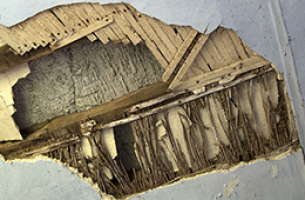Key Takeaways
- Lath & Plaster ceilings are very uncommon in modern buildings.
- They are prone to collapse, caused by vibrations or water damage.
- Your building surveyor will look for signs of collapse in your survey.
- They can be repaired and replaced, but you will need listed building consent if the property is listed.
What is a lath and plaster ceiling?
Modern internal walls and ceilings are finished with lightweight plaster board (also called 'drywall'), which is skimmed with plaster - most commonly gypsum. Plasterboard was invented in 1912, but the previous method of 'lath and plaster' was used through the early 1900's and is commonly found in houses built up until the 40's and 50's. As a traditional & sustainable building method, it can occasionally be found in younger homes.
The construction involves the nailing of thin, narrow strips of wood (laths) across the wooden studs or joists. A lime based plaster is then applied to the wooden base, which squishes through the gaps, moulding around the edges and clinging to it as it dries and sets.
What does a lath ceiling look like?

The image shows lath (above) and an even older method (below), 'wattle & daub'. Woven twigs of 'wattle' (the name of the plant) are woven through sturdier uprights; this was traditionally finished with 'daub' instead of plaster.
Daub is a combination of wet soil, clay, sand, animal dung and straw. This is a much older method and as such, there are very few surviving examples outside of listed buildings and restoration projects.
How do I know if my ceiling is lath or plaster?
If you are concerned about a prospective purchase, your surveyor will check during your survey. If you are wondering about a property you already own, you can carry out a DIY test by giving the ceiling a gentle tap with a broom handle. If it makes a hollow sound it is likely to be a lath and plaster construction, rather than modern plasterboard.
What causes lath and plaster ceilings collapse?
Any plaster ceiling can collapse, but due to their construction method, there are two main causes of lath and plaster ceiling collapse:
Over time, vibrations or water ingress can cause the moulded nibs of the aging plaster, which cling around the laths, to break away from the inch-thick surface layer. When a large enough area has broken loose, there is nothing fixing the plaster to the laths and the plaster layer of the ceiling can collapse.
How do you fix a sagging lath and plaster ceiling?
If the plaster is sagging, it is likely to collapse. If there are signs of damp, you may want to drill a small hole in the plaster, to allow any water which may be pooling and causing the sag, to drain through. However, as the ceiling is already compromised, drilling a hole into it may cause the whole thing to come down on you.
SAM Conveyancing recommends that you hire a professional to investigate and repair the damage, who should have proper professional indemnity insurance and protective equipment.
The preferred method is to remove the old plaster and laths, before plaster boarding the area and re-plastering, as most skilled plasterers do not specialise in lath and plaster.
Can I plasterboard over lath ceiling?
It is sometimes possible to plasterboard over the old ceiling, fixing through to the timbers beneath the old plaster and then fresh plaster on top.
This offers a less disruptive solution and can be attractive to owners of listed buildings, where the removal of original lath and plaster requires listed building consent. Unfortunately, it adds weight and can leave underlying issues of leaks, damp, rot or woodworm, undetected.
Should I replace lath and plaster ceiling?
Lath and plaster ceilings are more prone to collapse than modern ceilings, but are more sustainable, breathable and form a part of the buildings history and character.
If the building is listed, you will not be able to replace a lath and plaster ceiling without listed building consent, which is unlikely to be granted, unless there is a problem with the existing ceiling. In any case, you are more likely to be asked to re-plaster the old lath.
If the building is not listed and is being gutted and remodelled, replacing the lath with a modern plasterboard ceiling is usually more cost effective (unless the laths are in good condition and you can get away with simply replastering them).
As the old saying goes 'If it ain't broke, don't fix it.'










